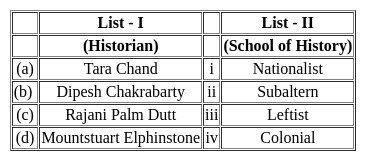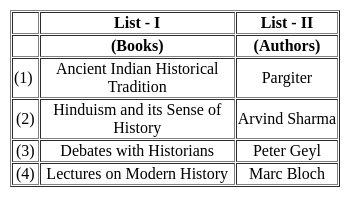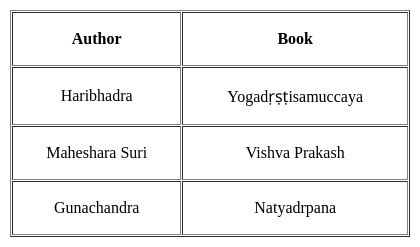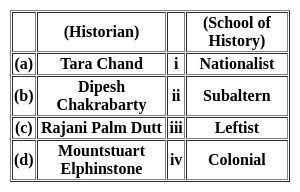TS SET Paper 2 Mock Test - 10 (History) - TS TET MCQ
30 Questions MCQ Test - TS SET Paper 2 Mock Test - 10 (History)
The statement 'knowledge is not found or discovered but rather is made by humans' is rooted in which school of thought of educational philosophy?
Who of the following was/were economic critic/critics of colonialism in India?
1) Dadabhai Naoroji
2) G. Subramaniya Iyer
3) R.C. Dutt
Select the correct answer using the codes given below:
Megasthenes has mentioned an Officer Astynomoi who was related with
Which of the following pairs are correctly matched?
- Ghatika: Ancient centre of learning
- Devaram: Composed by Nayanars
- Nalayradivyaprabandam: Composed by Alwars
Select the correct answer from the codes given below:
Lee commission was appointed in which year?
The distribution of powers between the Center and the States in the Indian Constitution is based on the scheme provided in the :
Which of the following statements are correct about the Sakyas clan?
- It was situated near the border of Nepal.
- Mahatma Buddha’s mother belonged to this clan.
- It had a unitary constitution.
- The capital of Sakya was Kapilavastu.
Select the correct option from the codes given below:
Consider the following statements with respect to the Sufi movement:
1. Sufism was a liberal reform movement within Islam
2. Sufism stressed the elements of love and devotion as an effective means of the realization of God.
3. Nizamuddin Auliya belonged to the Suhrawardi Order of Sufism.
Which of the statements given above is/are correct?
The term ‘Rashtra’ first appeared in which of the following periods?
In the context of later Vedic age, read the following statement(s) and select those that may not be correct?
1. It cannot be said that the Vedic society shifted to East.
2. The Vedic society used iron technology mostly for weapons of war.
3. In agriculture only labour intensive technology was used.
4. People married outside their 'gotra'
Select the correct answer using the codes given below.
Every Veda consists of which of the following parts?
- Samhita
- Brahmana
- Aranyaka
- Upanishad
Select the correct option from the codes given below:
Match the following and choose the correct option:

Which of the following statements is/are correct regarding Prarthana Samaj?
1. It didn't reject the Vedas and emphasized Bhakti towards God.
2. They were against the caste system and the practice of untouchability.
3. It opposed the idea of Widow remarriage but propagated Women's education.
At which of the following places the entry of women as Bhikshuni into the sangha was allowed by Buddha?
Which of the following pairs is/are correctly matched?
- Gandhara school: Grey sandstone/bluish-grey sandstone
- Mathura school: Spotted red sandstone
- Amravati school: White Marbles
Select the correct answer from the codes given below:
The Satavahana kingdom was divided into subdivisions which were known as?
Which of the following is not a composition of Saint Tulsidas?
Which of the following is not correctly matched:

Which of the following statements about Annales historians are true?
A. Annales School was name after the journal Annales.
B. Annales historians see history in terms of movement from past to the future.
C. Annales historians insist that they do not represent a school.
D. Annales school has influenced history writing in many countries including India.
Consider the following statements with reference to the Doctrine of Lapse.
1. The doctrine of lapse in India was solely an invention of Lord Dalhousie.
2. According to the doctrine, any princely state would automatically be annexed if the ruler died without a male heir.
Choose the incorrect statements.
With reference to Deccan Riots consider the following statements:
1. Here money lenders were mostly outsiders - Marwaris or Gujaratis.
2. Modern Nationalist Intelligentsia of Maharashtra opposed the peasants' cause due to the violence.
Which of the above statements is/are correct?
Which of the following kingdom were the prominent in 6th and 7th centuries BC?
Which of the following statement best summarises the nature of 1857 revolt?
Choose the correct pair:
1) Sahukar: acted as both a moneylender and a trader.
2) Rentier: people who lived on rental income from property.
3) Jotedars: Rich Zamindars and village headmen.
Consider the following statements regarding Fatehpur Sikri City:
1. The city was built by Mughal Emperor Akbar as a token of gratitude to Sheikh Salim Chisti.
2. The city is predominantly made up of Red Sand Stone.
3. It is a unique blend of Hindu and Islamic Architecture.
Which among the following above given statements are correct?
Who of the following viceroys sent Younghusband’s mission to Tibet?





















